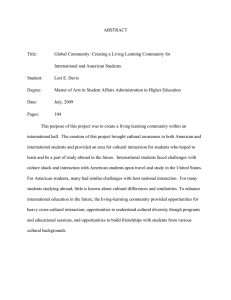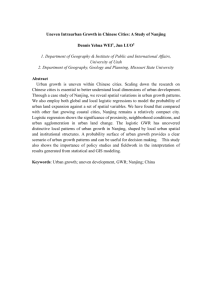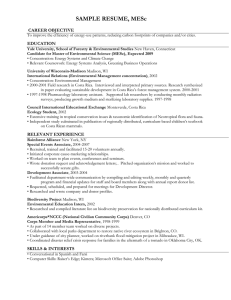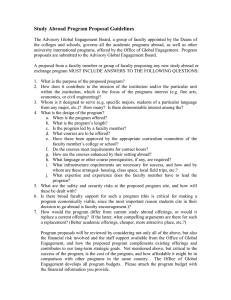abroad educAtioN designing an interdisciplinary
advertisement
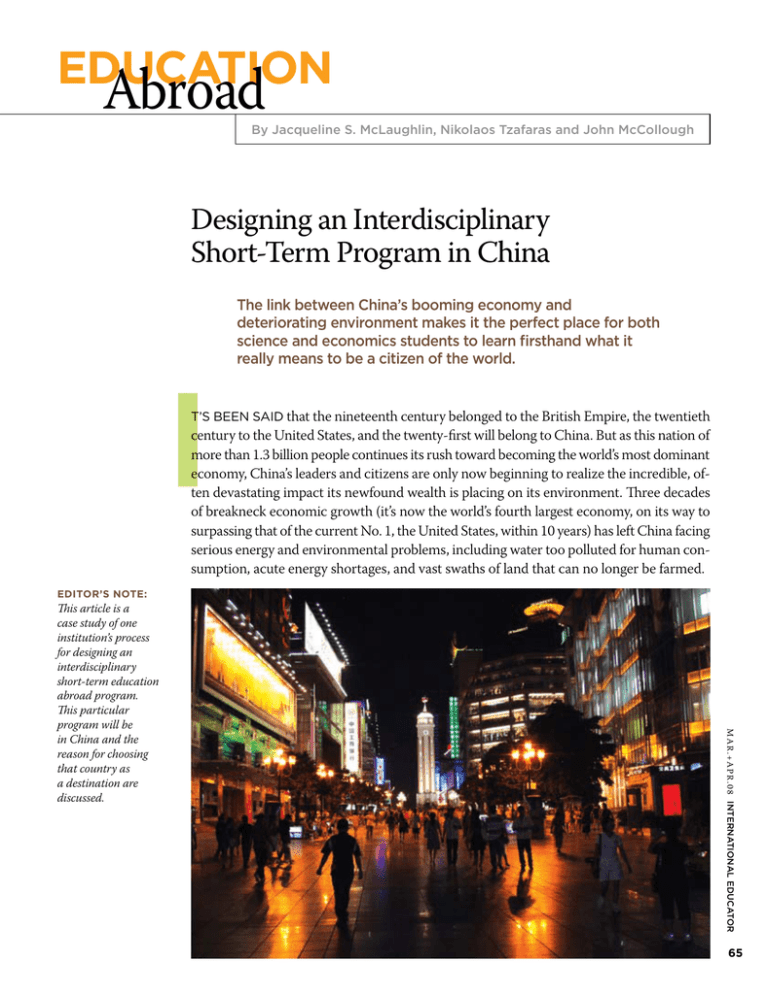
education Abroad By Jacqueline S. McLaughlin, Nikolaos Tzafaras and John McCollough Designing an Interdisciplinary Short-Term Program in China I The link between China’s booming economy and deteriorating environment makes it the perfect place for both science and economics students to learn firsthand what it really means to be a citizen of the world. t’s been said that the nineteenth century belonged to the British Empire, the twentieth century to the United States, and the twenty-first will belong to China. But as this nation of more than 1.3 billion people continues its rush toward becoming the world’s most dominant economy, China’s leaders and citizens are only now beginning to realize the incredible, often devastating impact its newfound wealth is placing on its environment. Three decades of breakneck economic growth (it’s now the world’s fourth largest economy, on its way to surpassing that of the current No. 1, the United States, within 10 years) has left China facing serious energy and environmental problems, including water too polluted for human consumption, acute energy shortages, and vast swaths of land that can no longer be farmed. Editor’s Note: m a r . + a p r .0 8 International Educator This article is a case study of one institution’s process for designing an interdisciplinary short-term education abroad program. This particular program will be in China and the reason for choosing that country as a destination are discussed. 65 International Educator m a r . + a p r . 08 66 What does all this mean for the average business or science major in the United States? Not much more than an interesting series of stats and anecdotes. Unless, that is, these two populations of students get the opportunity to see for themselves how economics directly impacts the environment—and vice versa. Indeed, contemporary China represents an environmental field station where valuable lessons can be learned. Creating short-term education abroad courses in China for undergraduate students that focus on the correlation between economic growth and its impact on the environment will create a powerful tool for effectively promoting global environmental stewardship. Forever there have been clashing views on environmental issues between economists and environmentalists. We in higher education are partly to blame for this. We define our disciplines as they relate to the content of our packaged textbooks. In doing so, we perpetuate the split. It’s our hope as educators that we can at last build a muchneeded bridge between the two fields. But to do this, we need to get students out of the classroom and into the real world. We envision a three-week program that entwines the environmental and economic realities in the field. And by doing so, we believe, the arguments between the two will be lessened, and our students—the future scientists, CEOs, and policy makers—will agree that we need to work in concert with one another. As we learned from developing and assessing a successful “Field Course Experiential Learning Model” in Costa Rica for undergraduate biology students, such handson learning promotes a deep understanding of key scientific concepts. One participating student, for example, commented: “Wow! I have never learned so much in such a short amount of time, or remembered so much of it! The stuff learned is still in my head, everyday, unlike other classes that you forget all the things you learned. We experienced what we were learning, and that made all the difference.” And yet another student reported, “Our field guide … made great connections illustrating cause and effect relationships. Two Disciplines, One Goal M arrying environmental and economic study seems so obvious now that we’ve actually hatched a plan to study and address real-life issues in a country like China. But merging two disparate fields is far from simple. When contemplating a cross-disciplinary short-term study abroad program, here are a few crucial things to consider: ■P ersonality Matters Just as you wouldn’t choose a mate you didn’t adore, you want to pick your partner(s) across-campus wisely. After all, you’re going to be spending countless hours together outlining goals, writing proposals, creating and evaluating assignments, and so much more. Respect for the other’s work goes a long way, sure, but you also want to team with a colleague who’s as excited about the task at hand as you, easy to communicate with, open to compromise, and willing to share the workload. ■ Es tablish Parameters The most successful courses are those with a narrow focus. You may want to change the world, but realize there’s only so much that can realistically be accomplished in a short-term course. For example, with our China program, before settling on Nanjing University and the Jiangsu Province we visited many areas and academic institutions in the country. Everywhere we went people were excited about the possibility of a joint venture, but ultimately we had to narrow it down to just one partner and one region to focus our energies. ■K eep Your Eye on the Prize Remember your ultimate goal: teaching students. At every step of the planning process, ask yourselves: How will this benefit the student’s academic experience? This simple question will help you fine-tune your program’s course. We traveled much of the country, so I fell I know a lot about the geography and culture. We met many different types of Ticos who shared their opinions and feelings about conservation and human activities.” But that’s just the beginning. These types of eyewitness programs also encourage students to become more active participants in their own education. And, most important, students gain a better awareness of, and respect for, other disciplines, opinions, and ideas. In analyzing participating students’ field journals, assignments and surveys, we weren’t surprised to find that students made significant gains in their understanding of conservation biology. But the data also revealed an unanticipated result: In journal entries, 88 percent of students made unprompted statements about how the experience influenced them to behave more responsibly with respect to environmental issues as related to conservation practices—improving environmental behavior through non-regulatory means. In other words, done right, short-term studying abroad puts students on the fast track to becoming thoughtful global citizens. So why keep this model confined to Costa Rica? By applying the same principles used for the Costa Rica courses in creating a course in China, we’ve no doubt we can make great strides for international study. And, hopefully, our students and faculty can directly apply what they’ve learned to better the environment for the Chinese—and, indeed, the world. Why China? Why Now? There’s no question that a course such as this could be positioned anywhere in the world. Environmental problems and economic booms are far from unique to China, after all. But to us, China is the perfect place to bring these two student populations together because it’s currently experiencing economic and environmental changes at such dynamic levels. For example, since eco- Selecting Jiangsu Province and Nanjing University W hen we first envisioned a short-term study abroad course in China, so many of the country’s precious environmental regions came to mind. During our trip this past summer, we had the chance to explore the country’s most dense urban centers, where we never saw a glimpse of a blue sky because of the thick cloud of pollution, as well as many of its rural areas, where once rich farmland is now a vast swath of industrial waste. While it would be wonderful to try to have our students study throughout China, realistically we needed to settle on one region and one Chinese counterpart. Jiangsu Province has long been China’s most populated, affluent, and educated region, especially in the southern portion of the province. Since the establishment of the port of Shanghai, it’s also been China’s most heavily industrialized region, responsible for a disproportionate percentage of China’s industrial production. For these reasons, in recent years, it has served as a test bed for Chinese efforts to implement an environmentally sustainable development model. Nanjing University was founded in the first decade of the twentieth century with significant American support. It’s one of the top five universities in China, and its research institutes are deeply involved in constructing and maintaining green practices (Jiangsu’s “Green Precinct Program”). Both Nanjing and Penn State are members of the Worldwide Universities Network, a major international network for research collaboration and graduate-level student exchange. The Jiangsu Environmental Protection Agency will provide support for the field research aspects of the study abroad program. of dire environmental challenges that pose catastrophic consequences for the entire world if not acknowledged and dealt with immediately. The extensive use of environmental resources due to industrialization, poor policy planning, and a desire for Western-style consumption have put sensitive ecosystems in grave trouble. China’s territory is as vast as it is diverse, with a total area of about 3.7 million square miles. The country has been blessed with a multitude of different terrains, including plains, deltas, hills, mountains, plateaus and deserts. Its climate varies from tropical in the south to sub-arctic in the north. China’s biological resources are among the worlds richest. This is not only due to its size, but also to the tremendous diversity of habitats. The world’s highest and lowest points are in Chinese territory, and it has a variety of ecosystems that is unequalled elsewhere— from glaciers to coral reefs and from deserts to tropical rainforests. m a r .+ a p r . 08 International Educator nomic reforms were put in place in the late 1970s (the country could no longer afford to subsidize industry and provide lifetime jobs for its citizens), China’s arguably witnessed the greatest improvement in human welfare in history. In the first six years after Deng Xiaoping (then leader of the China Communistic Party (CCP)) enacted the reforms, as many as 170 million people were lifted from absolute poverty. After being accepted into the World Trade Organization in December of 2001, the CCP’s leadership under Jiang Zemin and Hu Jintao one year later, made it easier for companies to operate in China by gradually opening the country’s domestic markets to international competition. Fast forward to today, China is now the key growth market for western companies thanks to a new generation of avaricious shoppers (called “chuppies”) who want everything yesterday. Sound familiar? Unfortunately, the counterpart to this much-welcomed wealth and power is a host Population pressures, however, have strained once vibrant farm—and rangeland to the point where vast swaths of once fertile ground has turned to desert—an irreversible process. The resulting annual economic loss from desertification of these lands is estimated at $6.5 billion (U.S.) annually. In the Yunnan province in the southwest, deforestation and the resulting erosion has been responsible for a change in climate (declining rainfall and rising temperatures) and the loss of hundreds of plant and animal species. Of course, the desire to produce more economic goods requires that China use its natural resources with more intensity. In several cities, local governments struggle to treat and process hundreds of millions of tons of trash and industrial solid waste (ISW), leaving the door wide open for toxins to find their way into local waterways. Every five years, China stockpiles close to 1 billion tons of untreated ISW. And, despite the establishment of tighter SO2 emission controls, acid rain continues to be a problem (leading to severe forest damage) thanks to the heavy reliance on coal as the primary energy source. All of the above has helped contribute to the pollution of China’s waterways. According to several studies published in a number of countries (including China), China ranks in the bottom third of nations in terms of water quality. Almost 60 percent of the more than 400 sites along China’s main rivers that have been monitored for water quality are too polluted for human consumption. Pollution has left nearly half of the water in the country’s rivers suitable for agricultural and industrial use only, making fresh drinking water a luxury for many of China’s 800 million peasants. Several villages are forced to deal with water supplies contaminated with fluorine, arsenic, high levels of salt or other industrial pollutants. In 2004 China’s State Environment Protection Administration said the country spent about $136 billion (U.S.), or close to 7 percent of its GDP, to clean up just one year’s worth of the pollution pumped into the country’s environment. Meanwhile, soaring demand, few conservation efforts and misguided policies have 67 caused regional water scarcity problems. About 400 major cities face water shortages and restrictions. The Yellow River, for example, is not only polluted and running dry, but the underground waters on which cities like Beijing increasingly rely on, are being pumped dry. More than 60 million people in China have limited access to water, and almost ten times that number drink contaminated water daily. As a result, factories are closing, tens of millions of people are leaving their land, public health is endangered, and the government faces a future of expensive river diversion and pollution remediation projects, even in areas once rich in water resources. In a September 2006 news briefing, China’s Vice Minister of Construction,Qiu Baoxing, declared, “China is at the crossroads in dealing with water problems.” China’s water shortage will be critical by 2030 when its population is expected to reach 1.6 billion. The ministry of water resources has calculated that by then China will need 130- to 230-million cubic meters of water more a year than now. Currently the 1.3 billion people of the world’s most populous country have at their disposal only a quarter of the water per person that is available on average around the world. International Educator m a r . + a p r . 08 A Country Ripe for Eager Students 68 While we have a pretty certain idea of where China’s economy is headed, we do not know what is in store for the future of its environment. Further industrialization of the Chinese economy will lead to more wealth for its people, which will give them the means (and, one would hope, the desire) to clean their environment. But without proper regulation or commitment, further deterioration of the environment can be expected. Either way, as it stands now, the interaction between the Chinese economy and the environment makes for an excellent study for the student interested in environmental management and practices, as well as students studying ways to shape future economic growth and policy. Yes, many countries, especially developing ones, are facing similar cause and effect Course Design Prerequisites Undergraduate: Biology 297 (4 credits)* Pre-trip—Complete all reading and Web site assignments. Trip—Maintain a daily journal; attend all programs/presentations; research one assigned species and one assigned ecosystem; partake in all field-based research activities. Post-trip—Submit selected journal entries, complete group reports on China’s environmental/economic sustainability; complete species and ecosystem assignments; complete final post trip questions. *P rerequisite for biology majors Biology 110 Prerequisite for business majors: Economics 002 and Economics 004 Undergraduate Upper Division / Graduate: Biology 497/ (4 credits)** Pre-trip—Complete all reading and Web site assignments. Trip—Maintain a daily journal; attend all programs/presentations; research one assigned species and one assigned ecosystem; partake in all field-based research activities; research and lead a group discussion on a course related topic (approved by Dr. McLaughlin). Post-trip—Submit selected journal entries, complete group reports on China’s environmental/economic sustainability; complete species and ecosystem assignments; complete final post trip questions. ** Prerequisite for biology majors: 8 credits of biology and 5th semester standing. Prerequisite for business majors: 8 credits of economics and 5th semester standing. Credits: Students can obtain credit in biology or business. Tuition Waiver: Students get credit for the course for the spring semester over their full-time load of 12 hours; therefore they pay nothing more for tuition for this education abroad experience. stories. But when you factor in China’s storied history—hardship suffered at the hand of harsh dictators, many wars, famine, population explosion, extreme poverty, newfound wealth—it makes one realize why it is important for China’s leaders to safeguard its precious ecosystems now. Already, its people are at risk from years of environmental decay and neglect due to poor management —remember the SARS scare from a few years ago? And cancer rates in the country have risen dramatically in recent years. Yet, there remains the possibility (hope) that China will rise to its challenges and become a great example for all countries to follow. On the other hand, if China’s government and scientists can’t quickly put themselves on the same page, its demise will be ours as well. We are all connected in our one biosphere. Countries have borders, the biosphere doesn’t. Now is the time for educators of both disciplines to commit themselves to fostering cross-learning and advocacy among their students. How great would it be for students with seemingly separate agendas to find a common ground and build a better understanding of the complicated relationship between the business world and the natural world? After hosting eager Chinese students at our campuses for decades, it’s about time for U.S. students to walk through China’s academic halls and work with some of that country’s esteemed researchers and educators. Experiential learning confronts students with the deeper meaning of globalization, such as an awareness of how human behavior and the environment impact one another, and are both connected and separate. What’s more, compared to traditional semester-abroad programs, short-term m a r .+ a p r . 08 International Educator 7<B3@</B7=</:32C1/B=@ Photo courtesy of Jacqueline McLaughlin 73( ! ! ! " %" $ &&12 ) 6 '61 )1 each%" to discuss possible"&+1"2)'. collaborations. We ! # %" ! $ $ ! also met with government agents )= to 6 gain 6 0&ac-6%$"' 6) =)9 !" %" !# cess to ongoing environmental project sites, ' 96)1 30/27( + 9'6"% *((8 ;2 ' 66)1'= ' )9' 6 1 ')'! 6 + "%)2)+ 12 the)' North-South Diversion1'"' Proj- "'6%%69 ):1'&'6% )1'">6")'2 , 2- "' 1'.such as126 ;2 +1)&"''6 ect, 2)' the Lake)' Tai;2 Region, the Yantgze River 9 6 ' "&+1"2)'. & : 2"' 6) +1)66 6 1" 62 ) 6 "%. Dam. 6After seeing "'$ 2 ) $ 6) 1' '61 )1 9&' " 62 ''62 ' ;and ) the +1) Three-Gorges )') ;)1$5 ' the enormous contrasts dif- 6) 2 + 6 ;=.of6the "2 +"'9% 6) ' 6 +)%"6"% +1"2)'12 ' 29++)16 6 firsthand "1 &"%"2. +1! 1" ferent we ) determined "'26 "' %221))&. +1 1+)162 )' 9&' 1" 62 26692 "' 1' :1= ;parts &)'6of 2.this country, the latter areas would be our planned 6 "1 6 6 ;)1$ )' "2 6 %' &"' . 1' "2three ') %)'1 field-based of interest. We ultimately 73( !" " "':)%: "' ;1 ;"6 1/ ; " %26 )1 " 6 =123 sites );:15 made contacts and set up connections with * =12 2 +22 2"' 6 ;1 96 6 1 1 26"%% %' &"'2'9! ! % # ! academes and professionals Nanjing &1)92 %' &"'2. "at" ! $ University (near Shanghai), the Jiangsu En-26+ 6 6 ' )= ; "% 0& 6%$"' 6) =)9 ; : ++1)<"&6%= )91 &"%! 30/27( 126 vironmental Protection Agency’s %")' 612 ) %' 6 6 )'6"' %' &"'2. ')169'6%= 1' "2 ;)&' 'research "%1'02 1" 62 "2 institute, and other non-governmental 6 2)' "26 )9'61= :"' %' &"'2. )+% )'6"'9%%= 6%$ )96 929%%=or"2 6 6 6 6 ganizations will be "' used 6 "6 1 "'#91 )1 " ;%$"' )' 6 &"'2. 6 ;01(NGOs) )"' that 6 &)'= 6 in 9' 2 )9% teaching6) the1"65 proposed field ;"6 6 "2 "2 +966"' +12291 )' 6 ):1'&'6 ; 6course. ;)9% ++' "' 6 '"6 the above;2 model’s com6 &"'2 ' #)"' 6 616= )' 6 1"6")' )We’d %'adapt &"'2. 2+'6three )' 96")'. Lake Tai in China—one of the planned field sites for this education abroad ponents: pre-trip preparation, trip experience %2) 61= 6) %+ 6 )2 ; ) 1 "'#91 = %' &"'2. experience. (or three-week practicum), and post-trip 73( %" ! $! %" Before!! actually landing9&' in China, 30/27( 1" 62 2+" 73( $% $% # %" ! !%synthesis. U.S. students would engage in extensive &= 269'62 environmental students education abroad programs that integrate instill 62. )169'6%= ! an $% ! ! ethic # in ! % %" !! !first1" the guidance of home and incorporate into background research (under assessment into innovative curricular de- that 1 :1= "'6) 6 29#6. $they $bring !! State faculty) to help them prepare for future careers, hopefully, sign offer students the same rich learning their 30/27( 'studies, &= )+"'")' 6 and, ;)126 )1 6 &)26Penn )++122 ) +1"2! In %" China, they’d with others. environments. Indeed, data from three years interactions 73( % " $ )'12 1 +)%"6"% +1"2)'12. 2 +)+% their 6 )1upcoming 1)& field ' work. under the faculty of Penn This past summer, toured of Chiof Penn State undergraduate field courses &)1= $ ' 6 =we+96 6 "1four %":2 6 1"2$ be ' 6 =the 1guidance 6$' of! Nanjing University, scientists, and gov- ! top colleges—Peking University, Nanjing shows that promoting experiences in rich na’s " 6) +1"2)'. ) ; : 6) %+ 6 &. %+"'State, 6 & )1 29++)16! leaders.' Working side by side with Fudan and' Chongqing environmental contexts through experiential University, "' 6 & ' University, '1)92 ;2 :'ernment 9 6 &=2% undergraduates in the field, with 6expert faculty learning not only advances the understand- University—and partici' %))$ $ 6 6 "&+1"2)' )1 6met 2& "'. ' %% at ) 6 Nanjing 66)1'=2 ; ) 15 30/27( ing of biological concepts, but also instills "' ;)& an environmental ethic, and should be con; )'06 sidered for application to other branches of ) +1)% study, and other countries. "%%= =)9 < Making it Work "%1' Using the Costa Rica semester-long “Field %); Course Experiential Learning Model” as a ')6 ' guide for running short-term study abroad %2) programs, we aim to launch a three-week 1"&"' program in 2008 that promotes an un'"' )1 derstanding of biological concepts and 6 6 " economic principles. In addition, we seek to 6 %; create a better understanding between our 6' ) two countries, and a better understanding ;)&' of the shared problems that we have, like 2& 1 how to make our economies more effi+9'"2 & cient, how to deal with energy needs, how 6)12 1 to deal with environmental problems, how %6 )9 to deal with educating our young students. ' +1) It’s also our hope that this experience will 6) ) % 69 pants will focus on real environmental issues, such as the eutrophication of China’s largest fresh-water body, Lake Tai, and the pollution of the Yantgze River due to industrial waste. There will be round-table discussion sessions and participant presentations. Additionally, U.S. and Chinese students will work together to write a report outlining possible solutions to China’s most pertinent environ- mental issues: water and air pollution, loss of biodiversity, global climate change, over-harvesting of marine and terrestrial ecosystems, and watershed management. As with the Costa Rica model, to maximize the field experience, students will maintain detailed daily journals (similar to field journals used by scientists to organize and document field observations) that will be < / 4 A /¸ A < 3 E 1 3 < B C @ G 1 7 @ 1 : 3 27/;=<2/<<7D3@A/@G 27>:=;/B 1 / ; >/ 7 5 < $ & International Educator m a r . + a p r . 08 7\ &</4A/eWZZQSZSP`ObSWba$bV /\\WdS`aO`gG]cQO\X]W\bVS<Se1S\bc`g 1W`QZS\]eOaO2WO[]\R/\\WdS`aO`g 2W^Z][ObBVWaa^SQWOZQO[^OWU\PSUO\ W\8O\cO`g $O\ReWZZ`c\bV`]cUV 2SQS[PS`! & 70 <]eWbWag]c`bc`\b]S\ac`S</4A/¸a 4cbc`SES[cabVSZ^bVS\SfbUS\S`ObW]\ ]TabcRS\ba]PbOW\UZ]POZQ][^SbS\QSb] [SSbbVS\SSRa]TOe]`ZRPOaSR]\[O`YSba b`ORSO\R´Sa^SQWOZZg´W\bS`\ObW]\OZc\RS` abO\RW\U BECOME A NEW CENTURY CIRCLE DIAMOND ANNIVERSARY DIPLOMAT. PLEDGE NOW! For more information on how you can join other NAFSAns who are determined to strengthen and sustain our legacy for future generations of international educators, e-mail gailh@nafsa.org, call 202.737.3699 ext 223, or visit www.nafsa.org/ncc. /ZZW\_cW`WSaO`SQ]\¿RS\bWOZ/Q][^ZSbSZWabW\U]T<11[S[PS`a QO\PSaSS\Obeee\OTaO]`U\QQ evaluated at the end of the course. They’ll also record, evaluate and report all data gathered from daily research activities. Students will be required to perform authentic tasks that demonstrate knowledge and skills gained. Once back home, students will face reflective activities and Web-based assignments designed to encourage the integration and application of key concepts learned. The most significant part of the “synthesis” stage is devoted to students translating the principles of experiential learning to their own immediate surroundings and daily life. Key here is that students will apply the principals of modern environmental science to the development of a sustainable Chinese economy. If successful, we’ll have illuminated for students the tight parameters policy makers must work within when making decisions with environmental and socio-economic impact. Ultimately, programs like this would at long last bridge the gap between the two fields and create a new generation of global environmental stewards. For as wildlife conservation researcher and writer Howard Youth argues, the actions needed to protect biodiversity not only have economic benefits, but also are the same actions needed to ensure a sustainable future for humanity. IE Jacqueline S. McLaughlin is assistant professor of biology at The Pennsylvania State University, Lehigh Valley Campus. She is also Founding Director of the international CHANCE Program and editor of its modules. She has led numerous experiential field courses throughout Pennsylvania, Alaska, Australia, China, Costa Rica, Ecuador, Galapagos Islands, Panama, Peru, Tanzania, and Costa Rica using her “Classrooms without Walls: Experiential Field Course Model.” Nikolaos Tzafaras is a retired member of technical staff and technical manager in the optical telecommunications industry. He is a natural scientist with a keen interest in social, political, and environmental developments. John McCollough is assistant professor of business at The Pennsylvania State University. His expertise is in the field of environmental economics.


